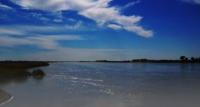Вы здесь
Murghab river in Turkmenistan.

Tour to Turkmenistan.
“Sweetness shudders through the land
as if, freed from the heat,
nature’d scooped spring waters in her hand
and splashed her burning feet”
Fyodor Ivanovich Tyutchev. “Summer evening”.
Photo tours on the monuments in Turkmenistan.
The Murghab River flows in Turkmenistan and Afghanistan. The length of the river is 978 kilometers, the basin area is 46.9 thousand square kilometers. The source of the river is located in Afghanistan in the Paropamiz mountains.
In the upper reaches, it is a typical mountain river, flowing in a narrow valley, sometimes turning into a gorge. After a significant tributary of the Abi-Kaisar flows into the Murghab, it enters Turkmenistan, where the length is about 350 kiometers.
Here the river flows in a clearly delineated valley up to 7 kiddle meters wide. The entire valley, up to the delta, is divided into two sections: an ancient one, composed mainly of sands, subject to significant erosion, and a younger one, where clayey deposits are developed.
In the lower reaches, the valley merges with the lowland, forming a vast dry delta. Murghab is one of the most water-bearing rivers in Turkmenistan. The left tributaries - Kashan and Kushka - have a significant impact on the formation of the spring flood of Murghab.
Below these tributaries, the Murghab channel is blocked by a number of dams, and the created reservoirs regulate the spring flow of rivers. The Kaushut-Bent dam divides almost all the remaining river flow between the canals, and the main river bed about 100 kilometers below the city of Mary dries up and is lost in the sands of the Karakum Desert.
The food is mostly snow. The average consumption of water near the village of Tagtabazar, which is 486 kilometers from the mouth, is about 52 cubic meters per second. Average turbidity of water is 4500 grams per cubic meter.
Near the city of Mary, the Karakum Canal flows into Murghab. Further, the river flows through the canal, and collectors from the Mary oasis drain into it. The channel-collector goes to the north-west, where it forms a network of lakes on the border of the Akhal and Mary velayats.
On the river are the Tashkeprinskoe, Kazyklybentskoe, Kolkhozbentskoe, Iolotanskoe, Hindukush and Saryyazinskoe reservoirs. The tributaries of the Murghab River are the Abikaysor, Kashan, Kushka, and Kaisor rivers.
Economic importance is the irrigation of agricultural lands. Irrigation in the Murghab delta dates back to ancient times.
Authority:
http://www.cawater-info.net/bk/water_land_resources_use/docs/rivers.html







